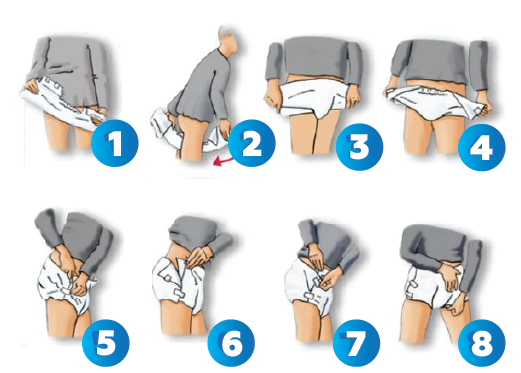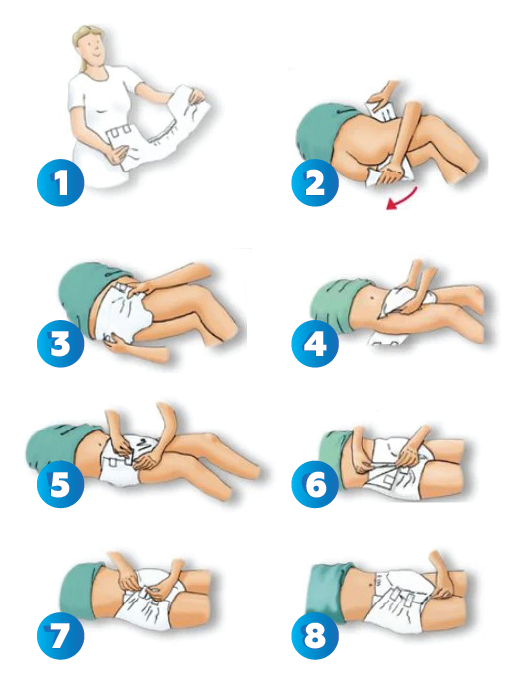
Summary
There are various products available today to meet the needs of individuals with incontinence, and adult diapers with tabs are one of the many solutions. Adult diapers with tabs are commonly used by individuals with limited mobility and/or heavy incontinence, and trying them for the first time can be confusing or stressful, whether you are putting them on yourself or helping put them on a loved one. Learn how to apply adult briefs with tabs with this step-by-step guide.
Click a link to jump to the section.
Introduction
Millions of people in the United States today1 currently live with and manage incontinence symptoms. Adult diapers with tabs, also referred to as incontinence briefs, are a great choice for managing incontinence. However, individuals with mobility issues may benefit the most2 from adult diapers compared to other users. Adult briefs are only at their most effective when applied correctly. Putting an adult diaper on yourself or someone else can be a daunting task; this guide can help you learn how to properly put on adult diapers to get the best protection.
Why Proper Application Matters
Improper application and fit can reduce and even eliminate the effectiveness of adult diapers, causing leaks and messes that could otherwise be prevented.
If the diaper is too tight, it can cause discomfort and chafing, irritating the skin and affecting circulation. A tightly fitting diaper can hold urine and fecal matter too close to the skin3, causing diaper rash and irritation from prolonged exposure. Liquid from the diaper may even seep out and stain clothing.
If the diaper is too loose, liquid may run out through leg openings or from the waist opening while lying down. Too large diapers usually have a bulky fit that shows through clothing, and parts of the diaper may stick out or bunch up uncomfortably while walking or moving.
How To Put Adult Diapers on Yourself
- Hold the clean diaper out in front of you and fold it lengthwise. The backsheet should be turned outward. Do not touch the inside of the diaper; this helps prevent contamination.
- Pass the folded diaper between your legs so the back panel is at the back of your body and the front panel is at the front. Keep your legs together to hold the diaper in place for the next steps.
- Fan out the front panel and shape it around the front of your body, pulling it taut to prevent creasing or bunching.
- Do the same with the back panel, pulling it taut over your backside with the backsheet turned outwards.
- Stretch the left side tab outwards until the diaper feels secure, and attach it to the front panel. Repeat the same with the right side tab.
- After attaching the tabs, move around and take a few steps to ensure the diaper fits comfortably. Adjust and refasten the tabs as needed for a snug, comfortable fit. A diaper that fits securely and comfortably provides the most effective incontinence protection.4


How To Change Someone Else's Diaper
You will need:
- A new, clean diaper
- Hygienic cleansing wipes
- Disposable medical gloves
- Barrier cream
- Protective underpad
- Plastic trash bag and/or wastebasket
Remove the Soiled Diaper
- Thoroughly wash your hands before putting on medical gloves.
- To protect against potential spills or messes while changing, you can place a protective cover (like a disposable underpad) on a flat surface, usually your loved one's bed. Underpads can protect furniture from any mess that might happen while changing.
- If they're not already, help your loved one lay on their back on the underpad.
- Unfasten the tabs on the front panel of the diaper; pull the front panel down.
- Use hygienic cleansing wipes to clean any incontinence that may have accumulated on the front of the body. Place the used wipes in the trash bag.
- Tuck the side of the diaper farthest away from you under the hip.5
- Place a hand on their hip and the other on their shoulder; gently roll them onto their side, facing away from you.
- If the diaper was tucked enough under the hip, you should now be able to pull the diaper out from underneath them. As you pull out the diaper, roll it inward to keep its contents from leaking or spilling.
- Dispose of the diaper.
- While they are still on their side, thoroughly clean the perineum and the surrounding areas with hygienic wipes. Avoid pressing or rubbing the skin with too much force.
- If there are lingering odors, irritation, rashes, and/or if they experience bowel incontinence6, you may also want to use a perineal wash for more effective cleansing.
- Check the condition of any bedsores and/or signs of developing bedsores. Treat them as necessary.
- When their skin is dry, apply barrier cream to the perineum as a preventative measure or to treat existing irritation or rashes.
- Dispose of soiled wipes, gloves, and underpads.
Putting On a Fresh Diaper
- Wash your hands thoroughly. Apply a fresh pair of medical gloves if it makes you or your loved one more comfortable.
- With your loved one still lying on their side, roll up a towel and place it between their knees. This will provide an opening for applying the diaper in the next step.
- Slide the fresh diaper into the opening (created by the previous step) between their legs. The diaper should be open, with the front panel towards the front and the back panel to the back (the back sheet turned outwards).
- Situate the back panel over their backside first. Pull it taut to smooth out any wrinkles or creasing.
- Gently roll your loved one onto their back again.
- Lift the front panel up and over the belly. Repeat what you did with the back panel and smooth out wrinkles or creasing.
- Align tabs by pulling them out horizontally. Attach tabs to the front panel one at a time and ensure each tab is securely fastened.
- Secure the diaper by angling the upper tabs downward and the lower tabs upward.
- The diaper should fit snugly with no gaps or pinching. Leg openings should fit securely around the legs to prevent leakage, but not secured so tightly that it would cause discomfort or chafing or prevent the wearer from moving comfortably.


Common Mistakes to Avoid
So you have followed all the steps for putting on an adult diaper, but there is still leakage happening - what can you do? Here are common mistakes people make in incontinence care that may help you identify the cause of your leakage issues.
- Not changing regularly: You may be waiting too long between changes. Try changing into a fresh diaper more often to see if this resolves the issue.
- Incorrect fit: Leaks can happen if a diaper fits too tightly or loosely. A diaper should fit snugly around body contours without gaps or material pinching the skin.
- Not enough absorbency: Incontinence levels can change over time. If you are experiencing frequent leaks and accidents, you may need briefs with heavier absorbency.
- Loose/too-tight leg openings: The leg openings of the diaper should fit snugly around the leg to hold in leakage; it also shouldn't fit too tightly to the point that it's restrictive, which can cause fluid to be squeezed out.
- Not using booster pads: Booster pads aren't always necessary; however, if you or your loved one are already using heavy absorbency diapers and still having leaks, a booster pad can provide additional absorbency protection.
Tips for Caregivers
Provide As Much Privacy As Possible:
- Always knock before entering the room.
- Keep doors and curtains closed. If needed, you can use dividers like screens or curtains to create a safe, private space.
- Choose somewhere private with a low risk of having someone walk in and interrupt.
- If it doesn't get in the way, you can cover the front of their body with a towel so they feel less exposed and more comfortable.
Keep Them Comfortable and Relaxed:
- Communication is key: Learn and respect your loved one's preferences for maintaining their dignity during changes. Having incontinence can make one feel they have lost control and autonomy, so keeping them involved in decisions made about their care and their body can grant them some security.
- Provide emotional support: Incontinence care can be embarrassing, vulnerable, and uncomfortable, so a calm, collected, and sympathetic attitude during a change can do wonders in helping them feel more at ease.
- Keep all the essential supplies on hand: Make sure you have protective incontinence products to treat and prevent rash and irritation, like barrier creams and perineal cleansers. These products keep your loved one healthy and comfortable and are necessary for incontinence care.


Conclusion
Wearing adult diapers with tabs that have been properly fitted helps prevent leakage and accidents. Applying an adult brief with tabs takes time, patience, and care, but the long-term results will be worth the effort, simplifying incontinence management and cleanup.
Footnotes
- 1 "Incontinence: Symptoms & Treatment - Urology Care Foundation. (2024, October)." What is Urinary Incontinence?
- 2 "Carewell." Are Adult Diapers the Right Choice?
- 3 "Kara Miller. (2025, January 21). Because Market." Adult diaper size chart: Find the right fit for comfort and confidence.
- 4 "Healthwick USA." How to put on an adult diaper.
- 5 "Maguire, B. (2024, March 11). Carewell." How to Change an Adult Diaper: A Step-by-Step Guide.
- 6 "Hoss, E. (Ed.). Medlineplus medical encyclopedia. MedlinePlus." Skin care and incontinence
